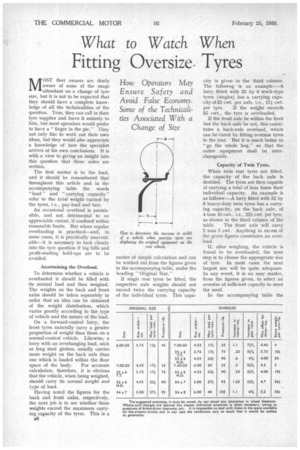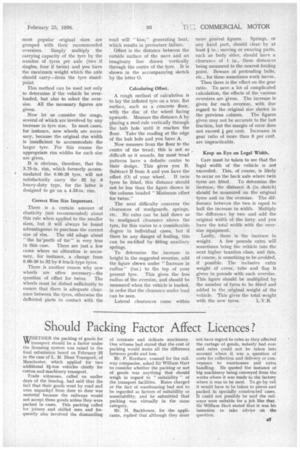What to Watch When
Page 40

Page 41

If you've noticed an error in this article please click here to report it so we can fix it.
Fitting Oversize_ Tyres
How Operators May Ensure Safety and Avoid False Economy. Some of the Technicalities Associated With a Change of Size MOST fleet owners are dimly aware of some of the snags attendant on a change of tyre size, but it is not to be expected that they should have a complete knowledge of all the technicalities of the question. True, they can call in their tyre supplier and leave it entirely to him, but most operators would prefer to have a "finger in the pie." They not only like to work out their own ideas, but they would also appreciate a knowledge of how the specialist arrives at his own conclusions. It is with a view to giving an insight into this question that these notes are written.
The first matter is to the load, and it should be remembered that throughout this article and in the accompanying table the words " load " and "carrying capacity" refer to the total weight carried by the tyres, i.e., pay-load and tare.
An occasional overload is permissible, and not detrimental to an appreciable extent, if confined within reasonable limits. But where regular overloading is practised-and, in some cases, it is practically unavoidable-it is necessary to look closely into the tyre question if big bills and profit-wasting hold-ups are to be avoided.
Ascertaining the Overload.
To determine whether a vehicle is overloaded it should be filled with its normal load and then weighed. The weights on the back and front axles should be taken separately in order that an idea can be obtained of the weight distribution, which varies greatly according to the type of vehicle and the nature of the load.
On a forward-control lorry, the front tyres naturally carry a greater proportion of weight than those on a normal-control vehicle. Likewise, a lorry with an overhanging load, such as long steel girders, usually carries more weight on the back axle than one which is loaded within the floor
space of the body. For accurate calculation, therefore, it is obvious that the vehicle, when being weighed, should carry its normal weight and type of load.
Having noted the figures for the hack and front axles, respectively, the next job is to see whether these weights exceed the maximum carrying capacity of the tyres. This is a
ne matter of simple calculation and can be worked out from the figures given in the accompanying table, under the heading "Original Size."
If single rear tyres be fitted, the respective axle weights should not exceed twice the carrying capacity of the individual tyres. This capa
city is given in the third column. The followng is an example lorry fitted with 32 by 6 truck-type tyres (singles) has a carrying capacity of 35 cwt. per axle, i.e., 1Ti cwt.
per tyre. If the weight exceeds 35 cwt., the tyre is overloaded.
If the front axle be within the limit but the back axle be not, this constitutes a back-axle overload, which can be cured by fitting oversize tyres to the rear. But it is much better to "go the whole hog," so that the entire equipment shall be interchangeable.
Capacity.of Twin Tyres. When twin rear tyres are fitted, the capacity of the back axle is • doubled. The tyres are then capable of carrying a total of four times their individual capacity. An example is as follows:-A lorry fitted with 32 by 6 heavy-duty twin tyres has a carrying capacity, on the back axle, of 4 tons 10 cwt.. i.e., 22i cwt. per tyre, as shown in the third coin= of the
table. The front axle will carry 2 tons 5 cwt. Anything in excess of the given figures constitutes an overload.
If, after weighing, the vehicle is found to be overloaded, the next step is to choose the appropriate size of tyre. In most cases the next largest size will be quite adequate. In any event, it is an easy matter, from the figures given, to select an oversize of sufficient capacity to meet the need.
In the accompanying table the most popular original sizes are grouped with their recommended oversizes. Simply multiply the carrying capacity of the tyre by the number of tyres per axle (two if singles, four if twins) and you have the maximum weight which the axle should carry—from the tyre standpoint.
This method can be used not only to determine if the vehicle be overloaded, but also to select the oversize. AU the necessary figures are given.
Now let us consider the snags, several of which are involved by any increase in tyre size. In most cases, for instance, new wheels are necessary, because the original rim width is insufficient to accommodate the larger tyre. For this reason the appropriate rim widths for each size are given.
It is obvious, therefore, that the 3.75-in, rim, which formerly accommodated the 6.00-20 tyre, will not satisfactorily carry the 32 by 6 heavy-duty type, for the Latter is designed to go on a 4.33-in. rim.
Correct Rim Size Important.
There is a certain amount of elasticity (not recommended) about this rule when applied to the smaller sizes, but it will always be found advantageous to purchase the correct size of rim. The old adage about " the ha'porth of tar" is very true in this case. There are just a few cases where no alteration is necessary, for instance, a change from 6.00-20 to 32 by 6 track-type tyres. There is another reason why new wheels are often necessary—the question of offset for twins. The wheels must be dished sufficiently to ensure that there is adequate clearance between the tyres, otherwise the deflected parts in contact with the road will "kiss," generating heat, which results in Premature failure.
Offset is the distance between the outside surface of the nave and an imaginary line drawn vertically through the centre of the tyre. It is shown in the accompanying sketch by the letter 0.
Calculating Offset.
A rough method of calculation is to lay the inflated tyre on a true, flat surface, such as a concrete floor, with the disc of the wheel facing upwards. Measure the distance A by placing a steel rule vertically through the hub hole until it reaches the floor. Take the reading at the edge of the hub hole and you have A.
Now measure from the floor to the centre of the tread; this is not so difficult as it sounds, for most tread patterns have a definite centre to their design. This gives you B. Subtract B from A and you have the offset (0) of your wheel. If twin tyres be fitted, this distance should not be less than the figure shown in the column headed "Minimum offset for twins."
The next difficulty concerns the clearances of mudguards, springs, etc. No rules can be laid down as to mudguard clearance above the tyre, for this varies to a considerable degree in individual cases, but if there be any danger of fouling, this can be rectified by fitting auxiliary springs.
To determine the increase in height in the suggested oversize, add the figure shown under "Increase in radius" (ins.) to the top of your present tyre. This gives the free radius of the oversize, and should be measured when the vehicle is loaded, in order that the clearance under load can be seen.
Lateral clearances come within more general figures. Springs, or
any fixed part, should clear, by at least in.; moving or swaying parts, such as body sides, should have a clearance of 1 in., these distances being measured to the nearest fouling point. Beware of protruding bolts, etc., for these sometimes work havoc.
Then there is the effect on the gear ratio. To save a lot of complicated calculation, the effects of the various oversizes are given. The increase is given for each oversize, with due• regard to the original size shown in the previous column. The figures given may not be accurate to the last fraction, but the margin of error does not exceed per cent. Increases in gear ratio of more than 8 per cent. are impracticable.
Keep an Eye on Legal Width.
Care must be taken to see that the legal width of the vehicle is not exceeded. This, of course, is likely to occur on the back axle where twin tyres are fitted. To determine the increase, the distance A (in sketch) should be measured on the original tyres and on the oversize. The difference between the two is equal to half the increase in width. Multiply the difference by two and add the original width of the lorry and you have the total width with the oversize equipment.
Lastly, there is the increase in weight. A few pounds extra will sometimes bring the vehicle into the next higher taxation class, and this, of course, is something to be avoided, if possible. The inclusive extra weight of cover, tube and flap is given in pounds with each oversize. This figure should be multiplied by the number of tyres to be fitted and added to the .original weight of the vehicle. This gives the total weight
with the new tyres. L.V.B.
































































































